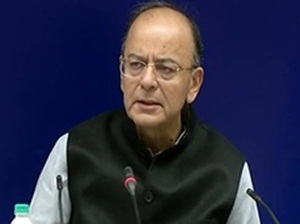Government on Monday announced the commencement of an amalgamation process of three state-run banks - Bank of Baroda, Vijaya Bank and Dena Bank - to create India’s third largest bank.

The first-ever three-way consolidation of banks in India will pave way to the creation of an entity with a combined business of Rs14,82,000 crore, making it India’s third largest bank, after State Bank of India and ICICI Bank.
The decision to merge these loss-making banks was announced after a meeting of the `Alternative Mechanism’ comprising its chairperson and finance minister Arun Jaitley and cabinet ministers Piyush Goyal and Nirmala Sitharaman in New Delhi on Monday.
With huge non-performing loans, these banks at present lack the capacity to expand credit and a merger to create a larger entity with higher net worth and higher financial clout is seen as the only way to instil confidence in these banks.
The merged entity will have an advances base of Rs6,40,000 crore and a deposit base of Rs8,41,00 crore.
But, with combined gross non-performing assets at roughly Rs80,000 crore in absolute terms, the gross NPA ratio of the merged entity will work out to be about 13 per cent.
Of the three banks, Dena Bank is currently under the Prompt Corrective Action (PCA) framework and has been restrained from further lending. It has a gross NPA ratio of 22 per cent - among the highest across the industry. Vijaya Bank, on the contrary, is among the better performing public sector banks with a gross NPA ratio of 6.9 per cent. Bank of Baroda, the largest of the three, has a bad loan ratio of 12.4 per cent.
For Bank of Baroda, the merger will mean a stronger presence in the western and southern regions, said PS Jayakumar, chief executive officer of the lender, adding that the merger will take 4-6 months. “The combined entity will benefit from a higher CASA (current and savings account) ratio and a well-diversified loan book,” said Jayakumar.
Reports quoting a former official at Vijaya Bank said the lender had approached the government to take over Dena Bank last year. Similarly Bank of Baroda is also reported to have approached the government with a proposal to merge with Vijaya Bank. The government seems to have taken the decision after considering both proposals.
The creation of larger, global size banks through merger of state-run banks with business synergies would help provide wider products and services and enhanced access, the government argues.
“The consolidation will help create a strong globally competitive bank with economies of scale and enable realisation of wide-ranging synergies. Leveraging of networks, low-cost deposits and subsidiaries of the three banks has the potential of yielding significant synergies for positioning the consolidated entity for substantial rise in customer base, market reach, operational efficiency, wider bouquet of products and services, and improved access for customers,” a finance ministry release stated.
Finance minister Arun Jaitley said the merger has been conceived in a way that the combined bank does not end up being weaker than the individual entities. There will be no adverse impact on employees and customers of the individual banks as a result of the proposed merger, Jaitley added.
Some of the strengths of the envisaged amalgamated entity are:
- Provision Coverage Ratio (PCR) at 67.5 per cent, which is well above public sector banks’ average (63.7 per cent), and steadily increasing;
- Net NPA ratio at 5.71 per cent significantly better than PSB average (12.13 per cent), and declining further;
- Gross NPAs for the combined entity have started declining (decline of Rs1,048 crore in Q1);
- Cost to income ratio of the combined entity at 48.94 per cent, which is better than the PSB average of 53.92 per cent;
- Dena Bank’s strength in MSME will further augment the strength of the other two to position the amalgamated bank for being an MSME Udyamimitra:
- Capital Adequacy Ratio (CAR) at 12.25 per cent is significantly above the regulatory norm of 10.875 per cent, and stronger amalgamated bank will be better positioned to tap capital markets;
- Significant cost benefits from synergies: Larger distribution network will reduce operating and distribution costs with benefits for the amalgamated bank, its customers and their subsidiaries;
- Global network strength of Bank of Baroda will be leveraged to enable customers of Dena Bank and Vijaya Bank to have global access;
- Access improvement through amalgamation of networks; and
- Wider range of products and services through leveraging of bank subsidiaries and leveraging of a larger network for offering more value-added non-banking services and products.
The merger of these three lenders follows the merger of State Bank of India and its associate banks in 2017. The SBI merger, which yielded good results, has prompted the government to take the next step in banking consolidation by deciding to merge three public sector lenders, according to Rajiv Kumar, secretary in the Department of Financial Services.








.webp)














